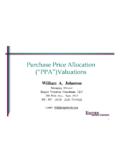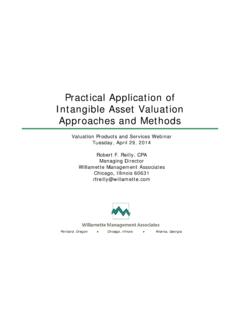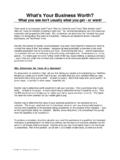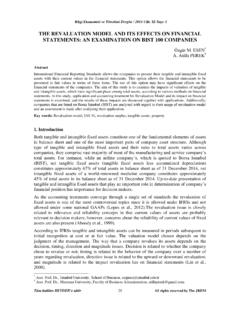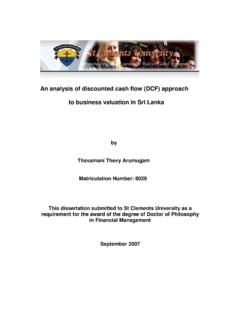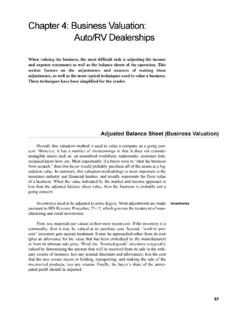Transcription of Purchase Price Allocation 101 - Empire Valuation …
1 Purchase Price Allocation 101 PRESENTATION BY:William A. Johnston, ASAM anaging Director(w) 212-714-0122; (e-mail) 10, 2008 ASA/AICP National Business Valuation ConferenceLas Vegas, NevadaPPA 101 Agenda Outline Overview (~ to hours)Introduction to Purchase Price Allocation Background and Purpose Purchase Price Allocation Process Appropriate Valuation methodologies Diagnostic tools (IRR, WARA) Case Study (~ to hours)Acquisition of Potato Chips Manufacturer/Seller (Cheesy Chips) Valuation of customers and trademarksCustomer retention rate discussion and cost to service supportAnalysis of selected royalty rate (benchmarks and profit split analysis)Discussion of IRR analysis and market participant assumptionsUse of WARA relative to WACC and IRR Q & A (time permitting)General Overview In a nutshell, what is It?
2 Allocate Purchase Price paid for acquired company to its tangible and intangible assets Deal-based Purpose Financial reporting Regulation/Oversight SEC Guidelines SFAS 141, 141(R),142, 157 SFAS 141, 142 Effective Mid-2001; 141(R) Effective in 2009; SFAS 157 Effective 2008/2009 (based on circumstances)Why PPA Valuations Matter to Companies Most intangible assets are amortized over their expected lives; this expense can have a major impact on reported earnings Goodwill typically tested for impairment on an annual basis following the acquisitionValuation Process Overview Determine Purchase Price and total asset base Identify components of total asset baseTangible assetsIntangible assetsGoodwill (remainder) Allocate value to company s asset components Reconciliation of asset conclusions This analysis focuses on intangible asset valuationValuation Process Purchase Price To know what to allocate, the Purchase Price must be identified Focus on market value of acquired company s equity and debt assumed, or market value of invested capital Non-debt liabilities added to MVIC of acquired company, to arrive at its total asset base, or total consideration.
3 New rules (SFAS 141R) impact on Purchase Price in 2009: Transaction costs no longer part of Purchase Price Contingent payments valued as part of Purchase Price In some cases, contingent liabilities will be valuedCalculation of Purchase Price (Numbers in $US thousands)Stock Consideration40,000 Cash Consideration125,000 Contingent Earnout Payments10,000 Total Equity Purchase Price175,000 Plus: Assumed Debt- Market Value of Invested Capital175,000 Plus: Assumed Liabilities *Accounts PayablePlus: Accounts Payable36,680 Plus: Accrued Expenses/Other14,000 Plus: Total50,680 Total Purchase Consideration/Total Assets225,680 Identify Components of Value Next Step - identify components that make up total asset base, in this case, $ million Components of valueTangible assetsValue typically estimated by client or through property appraisals Intangible AssetsSeparately identifiable assetsRemainder = GoodwillIdentification of Intangible Assets There are many types of intangible assets A typical case may involve half a dozen intangibles identified and valued Certain intangibles dictated by industry Recipes valued in food industry Web site members valued in internet industry Production processes and patterns valued for manufacturing companies Subscribers for magazines/newspapers FCC licenses for television stations or telecomIdentification of Intangible Assets (cont.)
4 Common Intangible Assets Include Trademarks/names ( Coca-Cola, IBM) Customer Contracts & Relationships Technology Workforce Patents Databases Non-compete Agreements In-process Research and Development ( IPR&D ) GoodwillIdentification of Intangible Assets (cont.) After identification, intangible assets must be classified into two categories: Identifiable intangible assets separable from goodwill Intangible assets not separable from goodwill Distinction made between assets that have a clearer basis of value vs. assets that have a more ambiguous basis of valueIdentification of Intangible Assets (cont.) According to accounting guidelines, an intangible asset is identifiable/separate from goodwill if:It arises from contractual or legal rights Patents Trademarks Customer ContractsIt can be sold, transferred, or licensed separately Technology Customer list NotworkforceNote: SFAS 141(R) has many examples of identifiable intangiblesSource.
5 SFAS 141(R)Standards of Value Standard of value for Purchase Price allocations for financial reporting is fair value For a comprehensive overview of fair value, please refer to SFAS 157 With a few exceptions, fair value is fairly similar to the fair market value standard for tax purposes Fair value focuses on an exit value concept, what a market participant would pay to buy an asset or transfer a liability For Purchase Price allocations, must exclude inputs that are unique to a specific buyer and not applicable to other market Approaches Income Approach Project cash flows attributable to asset over its useful life Similar to discounted cash flow analysis Methods include excess earnings method and relief from royalty method Market Approach Identify transactions of similar assets and use as a guideline to value Cost Approach Cost to replace an asset.
6 Net of obsolescence See SFAS 157 for full definitions of these approachesIncome Approach Excess Earnings Project future cash flows attributable to asset over estimated economic life Make sure that charges are taken for assets that contribute to the stream of cash flows generated Typically charges calculated as a percentage of sales Develop a weighted average cost of capital for the asset Projected cash flow streams are discounted to present @ WACC Rate To this value, a tax amortization benefit ( TAB ) factor is applied Present value of ability to amortize an intangible asset over a 15-year period, for tax purposesExcess Earnings Method - Example(Numbers in $US thousands) 1 Year 2 Year 3 Year 4 Year 5 Year 6 Year 7 Existing Customer Revenue267,750 273,105 278,567 284,138 289,821 295,618 301,530 Times: Retention Customer Revenue254,363 233,505 214,357 196,780 180,644 165,831 152,233 Less: Cost to Service Existing Customers (234,014) (214,824) (197,209) (181,038) (166,193) (152,565) (140,054) Cost to Service Margin (4) Income20,349 1 8 , 6 8 0 1 7 , 1 4 9 1 5 , 7 4 2 1 4 , 4 5 2 1 3 , 2 6 7 1 2 , 1 7 9 Less.
7 Provision for (8,140) (7,472) (6,859) (6,297) (5,781) (5,307) (4,871) Net Profit12,209 1 1 , 2 0 8 1 0 , 2 8 9 9 , 4 4 5 8 , 6 7 1 7 , 9 6 0 7 , 3 0 7 Less: Contributory Asset Charges%SalesWorking (1,272) (1,168) (1,072) (984) (903) (829) (761) Fixed (1,017) (934) (857) (787) (723) (663) (609) (3,052) (2,802) (2,572) (2,361) (2,168) (1,990) (1,827) Workforce in (254) (234) (214) (197) (181) (166) (152) Net Cash Flow6,613 6 , 0 7 1 5 , 5 7 3 5 , 1 1 6 4 , 6 9 7 4 , 3 1 2 3 , 9 5 8 6.
8 5 0 0 0 Times: Present Value 0 . 4 7 8 7 Present Value of Cash Flow6,249 5 , 1 2 2 4 , 1 9 8 3 , 4 4 1 2 , 8 2 0 2 , 3 1 2 1 , 8 9 5 Sum of Discounted Cash Flows32,894 Times: Tax Amort. Benefit Value of Customer Relationships40,722 Value of Customer Relationships:$41,000 Income Approach Relief from Royalty Estimates value for asset, based on the cost savings realized through ownership (vs. paying licensing fees) Cost savings determined, based on the royalty rate a licensor would pay for the asset Commonly used for trademarks/names and sometimes technology/patents Estimation of an appropriate royalty rate critical to the analysisRelief from Royalty Method - ExampleP2008P2009P2010P2011P2012P2013 Etc.
9 Projected Total Company Revenue270,000 302,400 338,688 372,557 409,812 426,205 Times: % Attributable to Revenue Attributable to Trade names189,000 211,680 237,082 260,790 286,869 298,343 Times: Royalty Royalty Savings3,780 4 , 2 3 4 4 , 7 4 2 5 , 2 1 6 5 , 7 3 7 5 , 9 6 7 Less: Trademarks Maintenance Expense(100) (103) (106) (109) (113) (116) Net Pretax Royalty Savings3,680 4 , 1 3 1 4 , 6 3 6 5 , 1 0 7 5 , 6 2 5 5 , 8 5 1 Less: Provision for Taxes(1,472) (1,652) (1,854) (2,043) (2,250) (2,340) After-Tax Royalty Income2,208 2 , 4 7 8 2 , 7 8 1 3 , 0 6 4 3 , 3 7 5 3 , 5 1 1 Times: Partial Period Discounted After-Tax Royalty Income1,113 Period (Mid-Period) Times: Discount Discounted After-Tax Royalty Income1,082 2 , 2 1 2 2 , 2 1 6 2 , 1 8 0 2 , 1 4 4 1 , 9 9 1 Sum of Discounted Royalty Streams40,477 Times: Tax Amort.
10 Benefit Value of Trademarks50,108 Value of Trademarks, Rounded:$50,100 Determining Royalty Rates Sources of guideline royalty rates include SEC filings Online databases( , RoyaltySource, RoyaltyStat) Subject company licensing transactions Previous engagements Profit splitting analysis Rule of thumb: one quarter to one third of operating profit reasonable proxy for a royalty rate to pay Often performed as a reasonableness checkAssessing Guideline Royalty Rates Comparability Type of Product(s) Profit margin of Product(s) Date of Transaction Exclusive vs. non-exclusive Remaining life of intangible and term of agreement Arm s length transaction? May not be, could be Legal settlement Between related parties Within same company between different countries Beware of references to articles! Geographic region Is transaction for bundled IP vs.
